David Bradshaw Photos - Part LXXXVII, Silhouette Part 5
Feb 13, 2016 11:49:52 GMT -5
awp101, lscg, and 2 more like this
Post by Lee Martin on Feb 13, 2016 11:49:52 GMT -5
1978 marked the second full year of IHMSA sanctioned matches. Those who breathed gunsmoke and slept with the CLANG of silhouettes in their ears hit the ground running. Competition divided between two categories of handgun: PRODUCTION and UNLIMITED. Production meant factory stock, with a trigger job——factory parts only. Aftermarket stocks finished to a standard pattern——Pachmayr indicative. Barrel length of 10-3/4” permitted, since that is what came on the Remington XP-100 .221 Fireball. However, the seminal XP Fireball was to be the only bolt action permitted, as Remington would find out in 1980 when it introduced the 7mm BR Remington, with plans for a 10-inch for Production to compliment the 14-1/2-inch Unlimited.
T/C dominated Production with its Contender, priced for the blue collar dollar. Single shot pistols chambering rifle-esque cartridges and featuring fast lock times made life rough for the revolver. Calls for a separate Revolver category fell on deaf ears. Revolver shooters fought back the only place where prestige cannot be bought----on the firing line. Among revolver shooters, top guns included Colt Python (no other Colt), S&W M-27, and the Dan Wesson Arms M-15. Choice among .41 Mags, the M-57 with 8-3/8” barrel. Selection of .44 mags seesawed between S&W M-29 and the Ruger Super Blackhawk.
David with two hard shooting .44’s. Photo taken by Elgin Gates in Arizona.
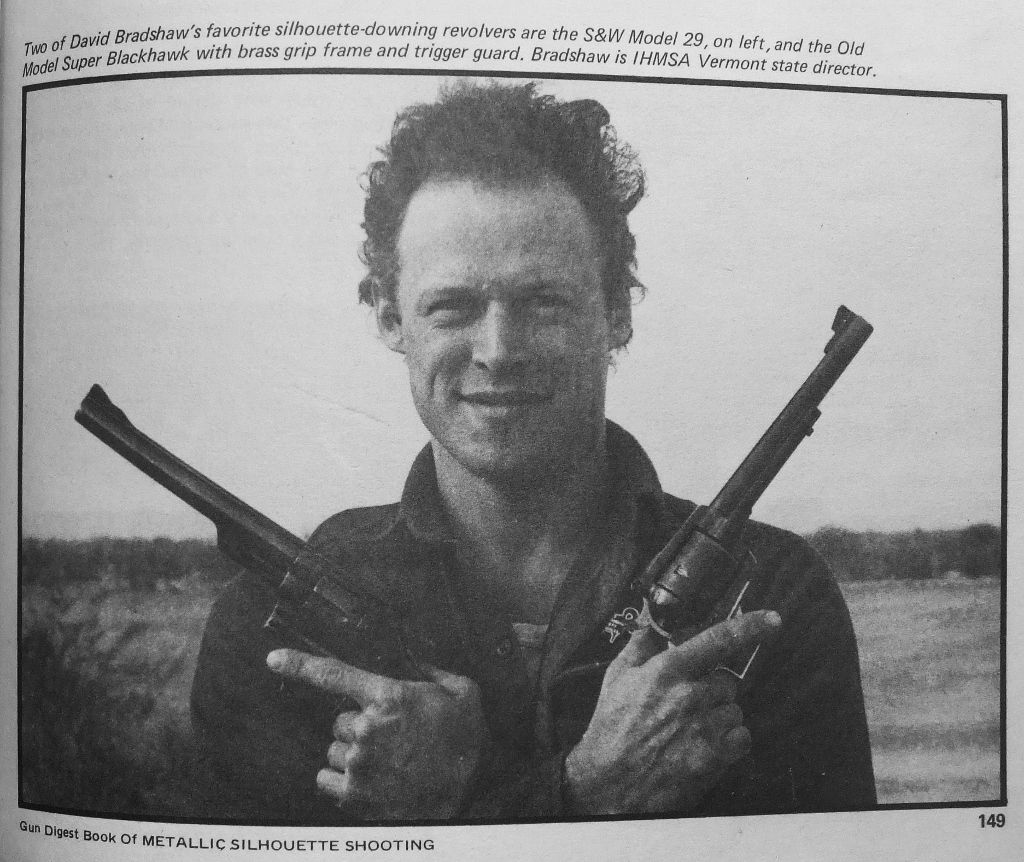
Competitors shoot XP-100 .221 Fireball in Production, Creedmoor position (foreground). The little crater-maker .221, a shortened .222 Remington, was guaranteed to ring targets. Nevertheless, the pistols enjoyed cult status in some areas. Rocks & Dynamite loads featuring the Speer 70 grain .224 semi-spitzes brazed a few bolt faces, proving the incredible strength of the Remington action. Laser beam trajectory obviated need to adjust abomination of a rear sight.
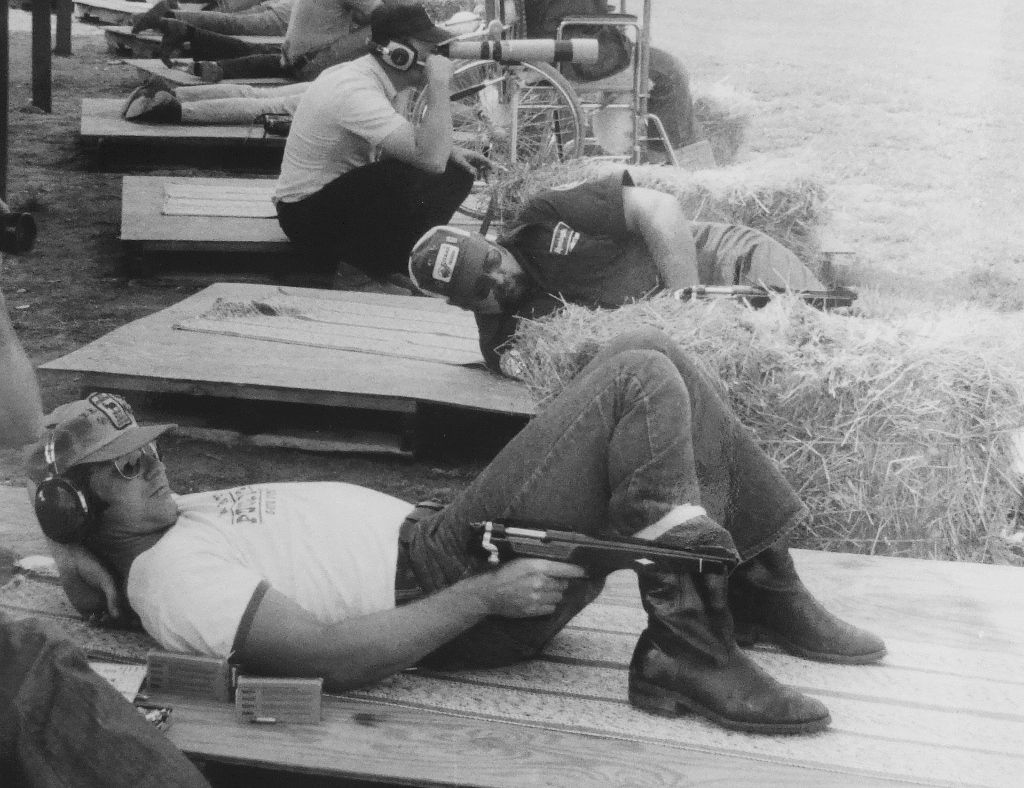
Remington XP-100 .221 Fireball single shot pistol shares solid bottom receiver of 40-X target rifle, rigid in the extreme. Dupont Zytel Buck Rogers stock allow pistol to make 4 lbs limit for Production guns

Competitor awaits ”FIRE” command at Jackson Center, Pennsylvania, close to the Ohio border. Jackson Center sported a group of alchemists dedicated to inflicting maximum target damage with Remington’s little screamer. Gentleman offered David a Mauser Model 3000 in 7mm Rem Mag, a fine copy of the SAKO: $250 or $275——with Leopold 2x7x! Alas, such money was needed for silhouette.

The sidewinder enjoyed among freestyle positions a modest following. Requires a wrestler's neck to hold up your head through an 80 round match, such as this championship. Neck strain of course leads to eye strain, neither of which afflicted this shooter
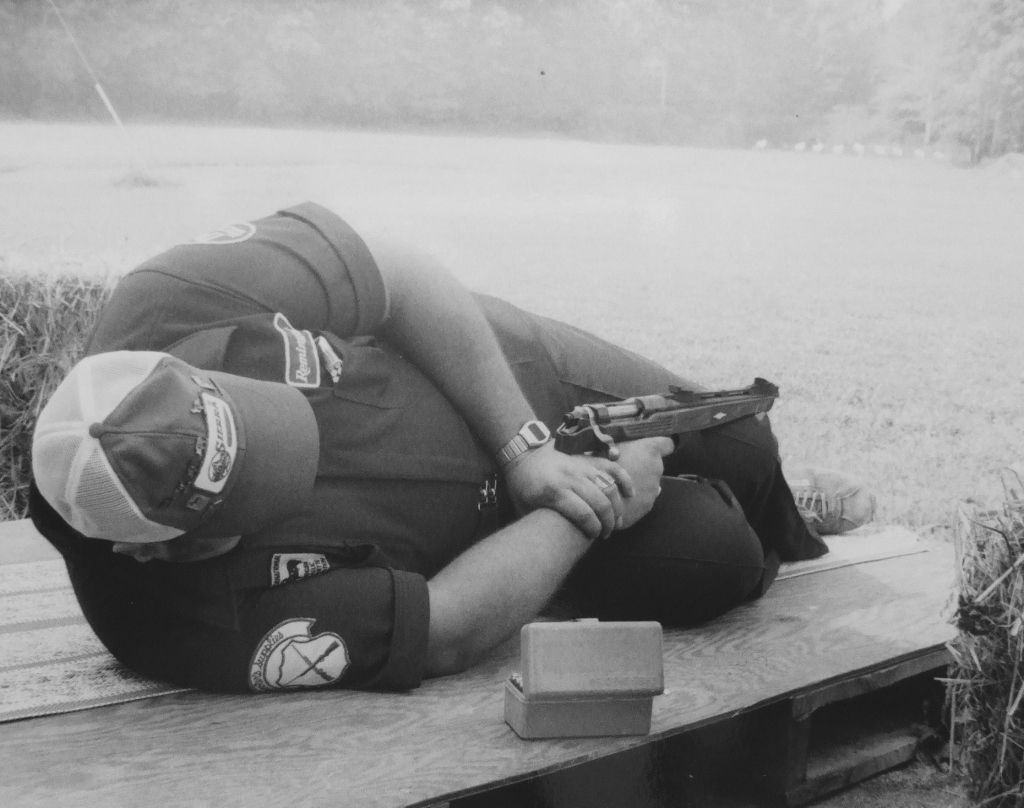
Original XP-100 as chambered in a shortened .222 Remington, dubbed “Fireball,” a fitting appellation for the small bore cannon. A bolt action of extreme strength, and the basis of most custom Unlimited pistols
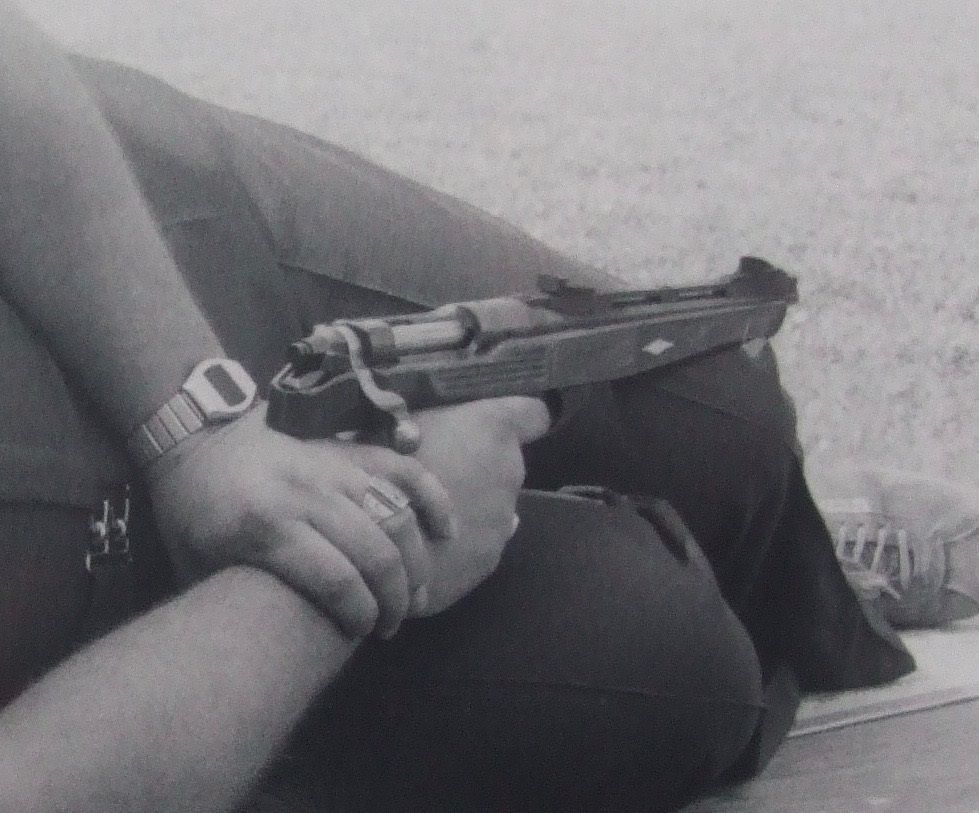
This pockmarked chicken obviously was cut from 1/2” mild steel. The .221 Fireball, and any warm 7mm or .30 craters mild plate as well. As will an especially fast .44 Magnum loaded with Rocks & Dynamite, or likewise stoked .357 Maximum. Over time most mild targets were replaced with T-1. When a target breaks, or feet fall off, a tough electrode such as 7018 works much better than milder series rod
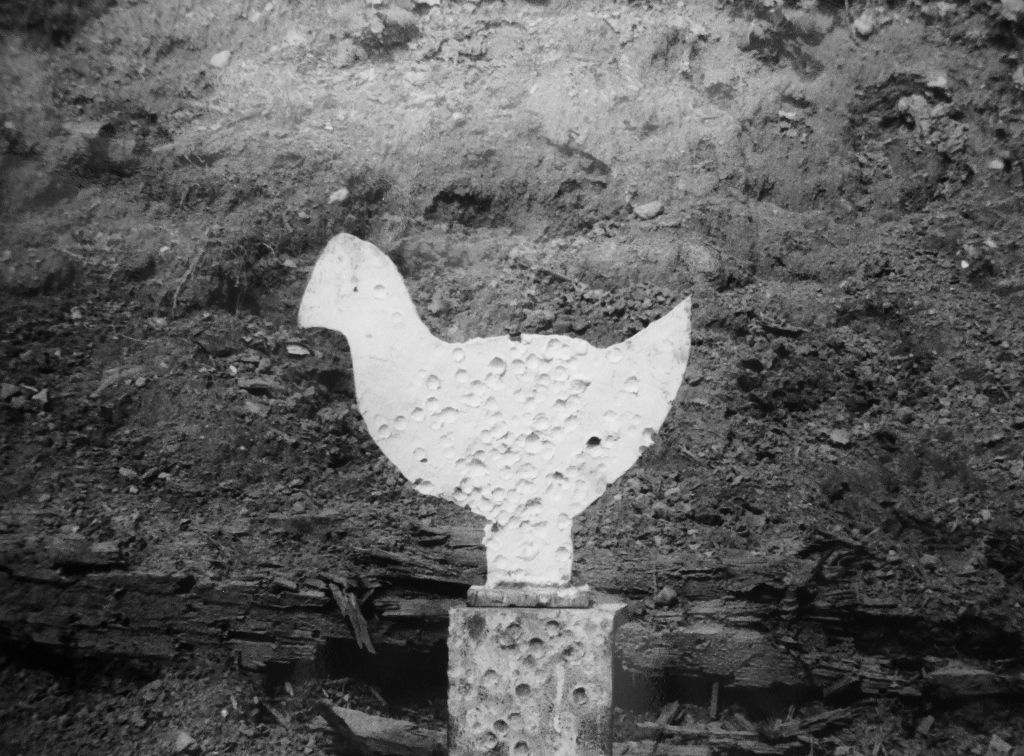
Pennsylvania sharpshooter Bechtel (blond) jawbones with Region One Director Ron Ricci. Bechtel, believes present writer, shot the first 40x40 east of the Mississippi. During this tournament the Calcutta Auction came down to Bechtel and Bradshaw.
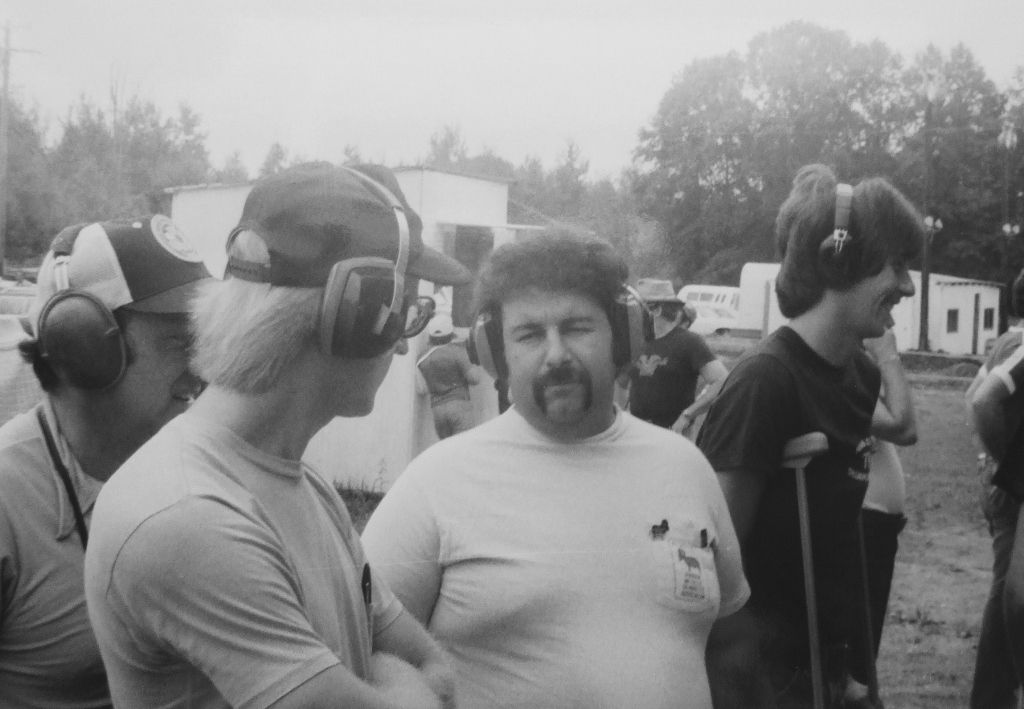
David puts his new Unlimited pistol to work at a Ron Ricci’s match, Camp Curtis Guild, Massachusetts. The XP was built by Nevada maestro Skip Talbot, who shot the 40x40 and 60x60 records. Douglas air-gauge 1:9, 7mm/308x1-3/4”. Thumbhole stock by Western Gunstock’s George Petersen. Blade front sight .075”; Micro rear, narrow notch. Talbot 1-lb. rework of Remington center-grip trigger. Glad bedded, secured by forward action screw only. Talbot copied his own gun for David.
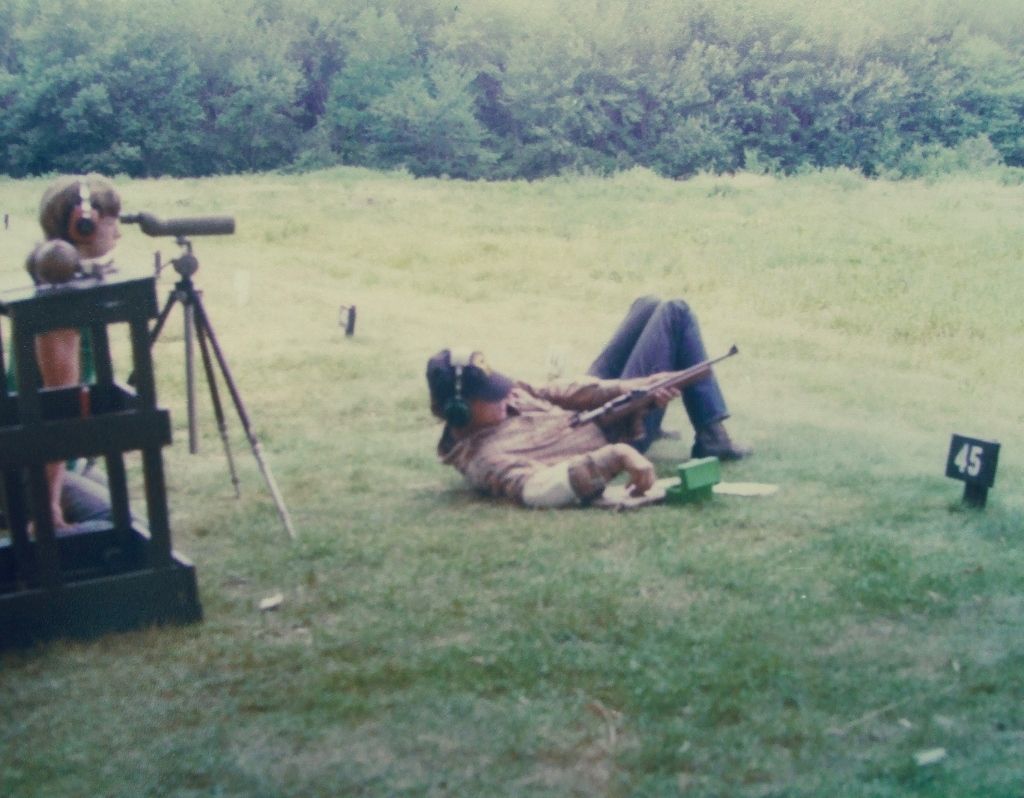
Nephew and spotter Jeff Kolok looks on as the shooter checks each silhouette for Point of Impact. This must be done as target setters lift silhouettes back on the stands——before painting bullet splashes. One perfect score had been fired east of the Mississippi, and few in the country
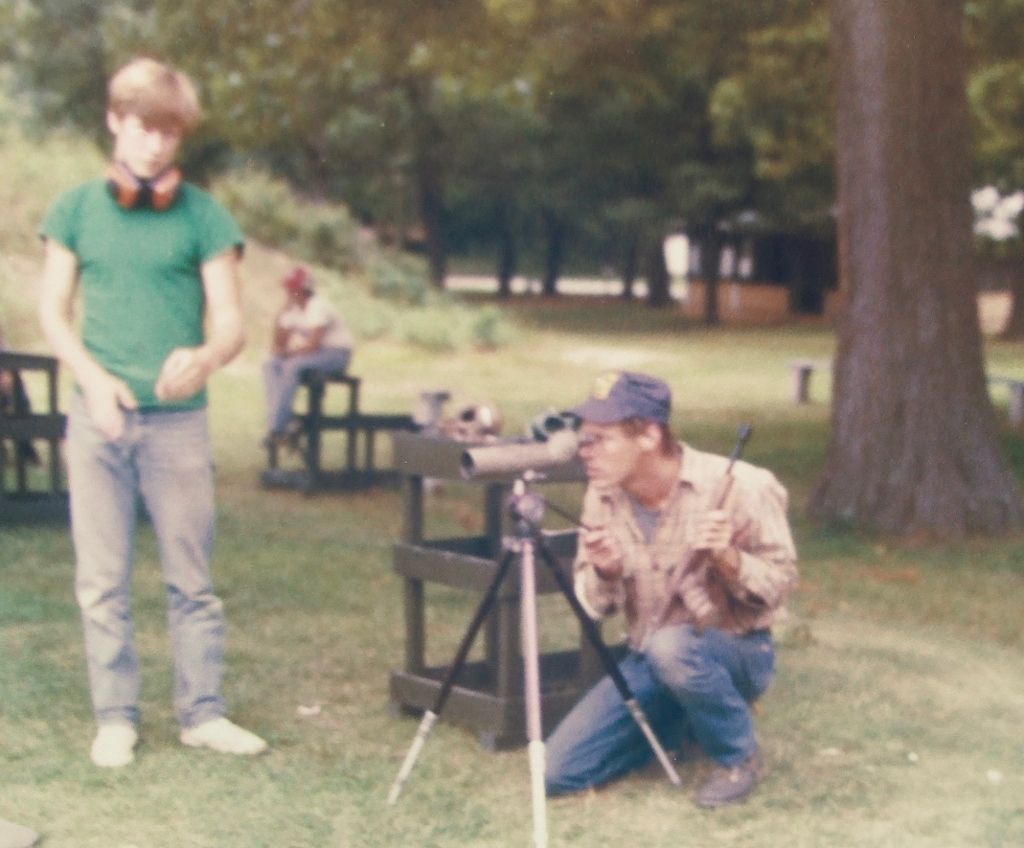
Ron Ricci congratulates shooter on the first 40x40 in New England
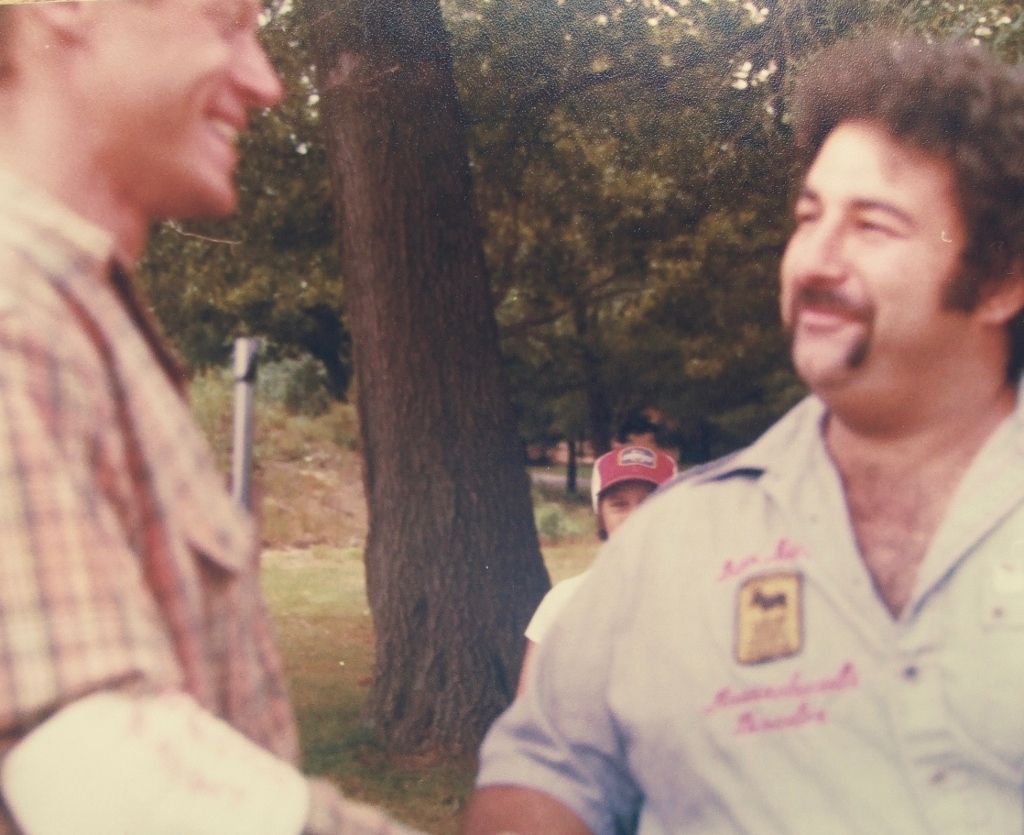
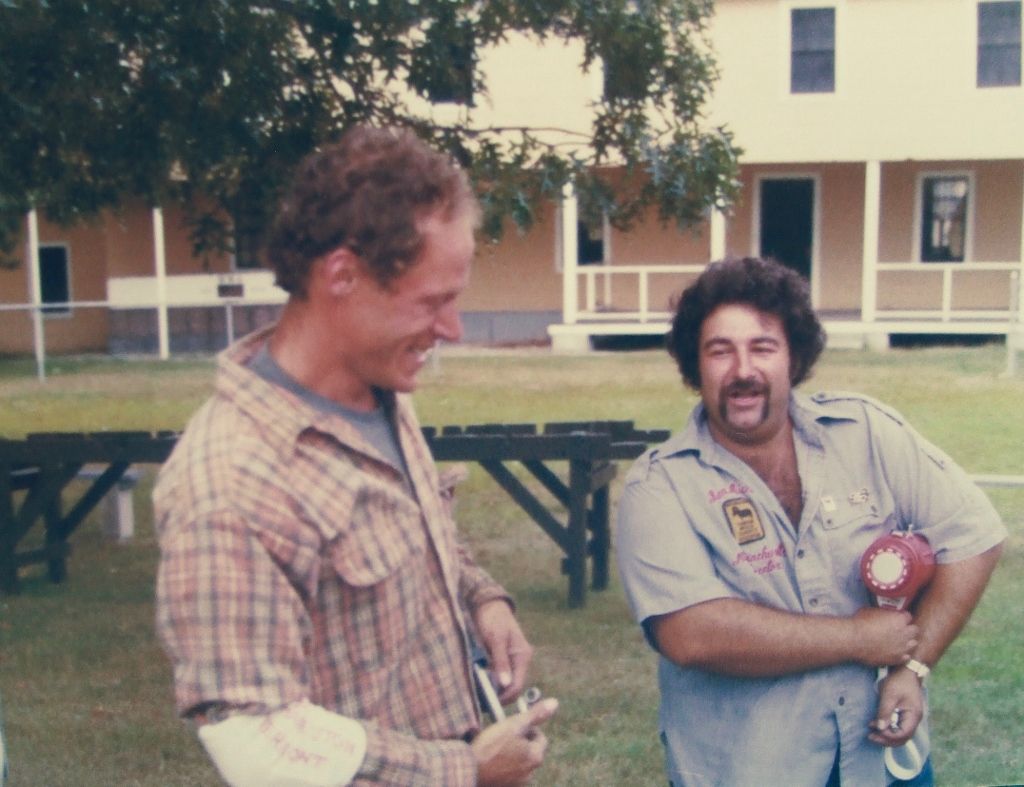
Scaled template of chicken shows a shootable rectangle in the body 5” high x 6” wide——but such an optimistic zone invites a miss. An 1/8-inch (.125”) front sight covers about 6” at 50 yards meters, depending on eye relief. The closer to your eye the front sight, the more target it covers. Creedmoor position offers the longest eye relief, and the blade covers less target.
Prone imposes the shortest eye relief of any position, and the front blade covers more target. Focus mind on the target. Focus eye or eyes on front sight. The rear sight may look a bit fuzzy----not as fuzzy as the target
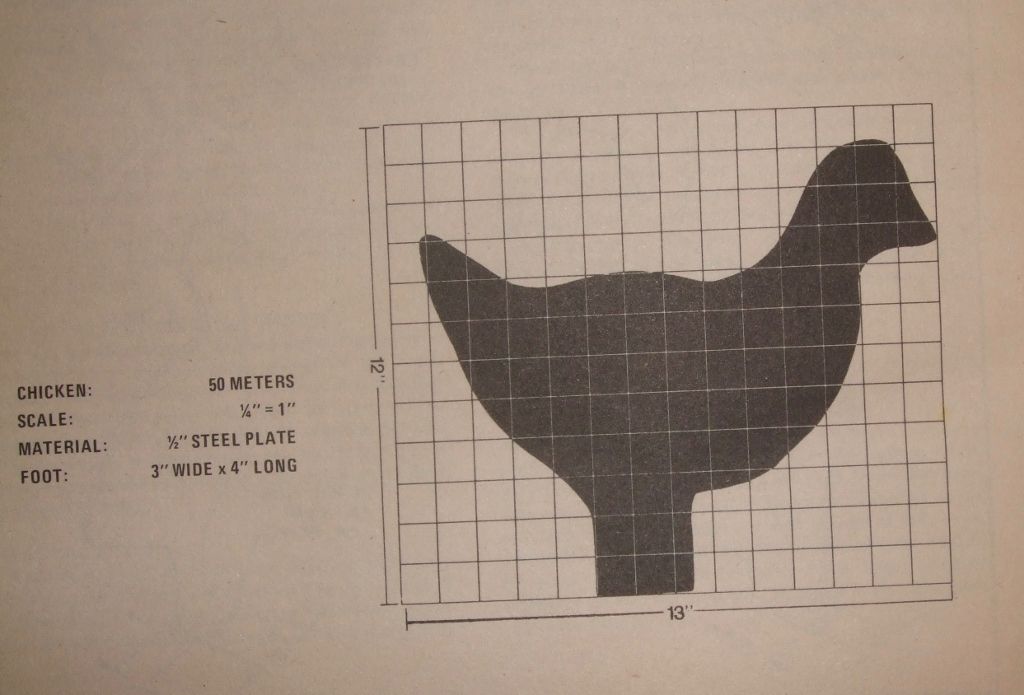
The pig is proportionately the largest silhouette. And, arguably, the most symmetrical——since it is closer and therefore easier to see than the ram. The pig is the roadmap for tuning your sights, and the roadmap on which to begin doping wind——especially shooting the revolver; 100 meters is distance enough to bend a revolver bullet.
The chicken is too close and falls so fast it is difficult to spot. And the chicken is too close to dope wind. A good place to hold on the pig is just over the front leg
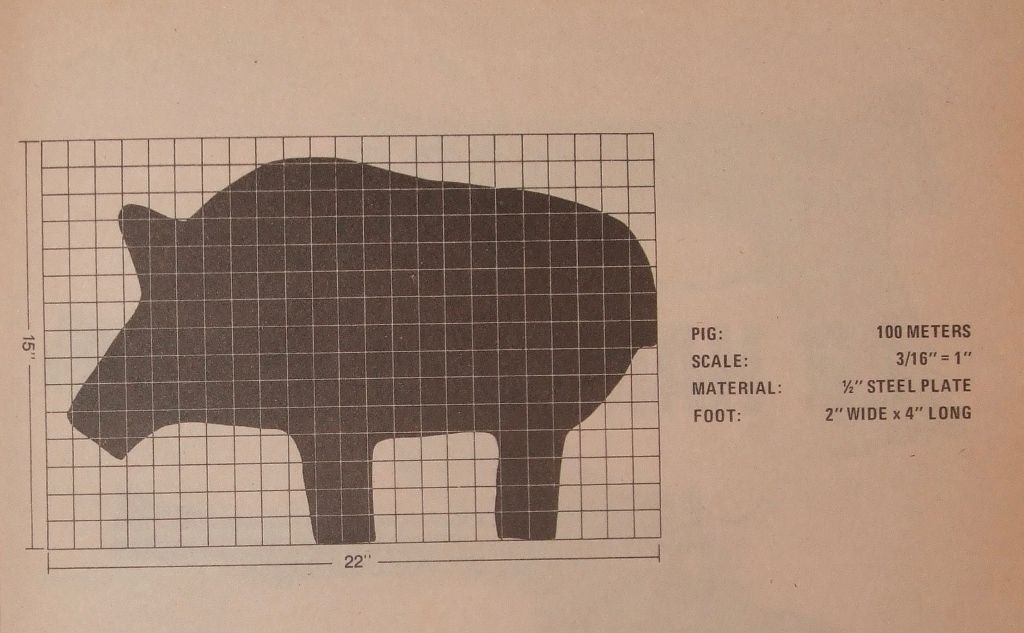
The asymmetric turkey presents the most difficult silhouette to fix your sights on. It stands 150 meters (165 yards) from your muzzle——one and two third football fields. An 8-inch square just about fits in the body, but the shooter must hold tighter than that. An eighth-inch front sight covers most of the body.
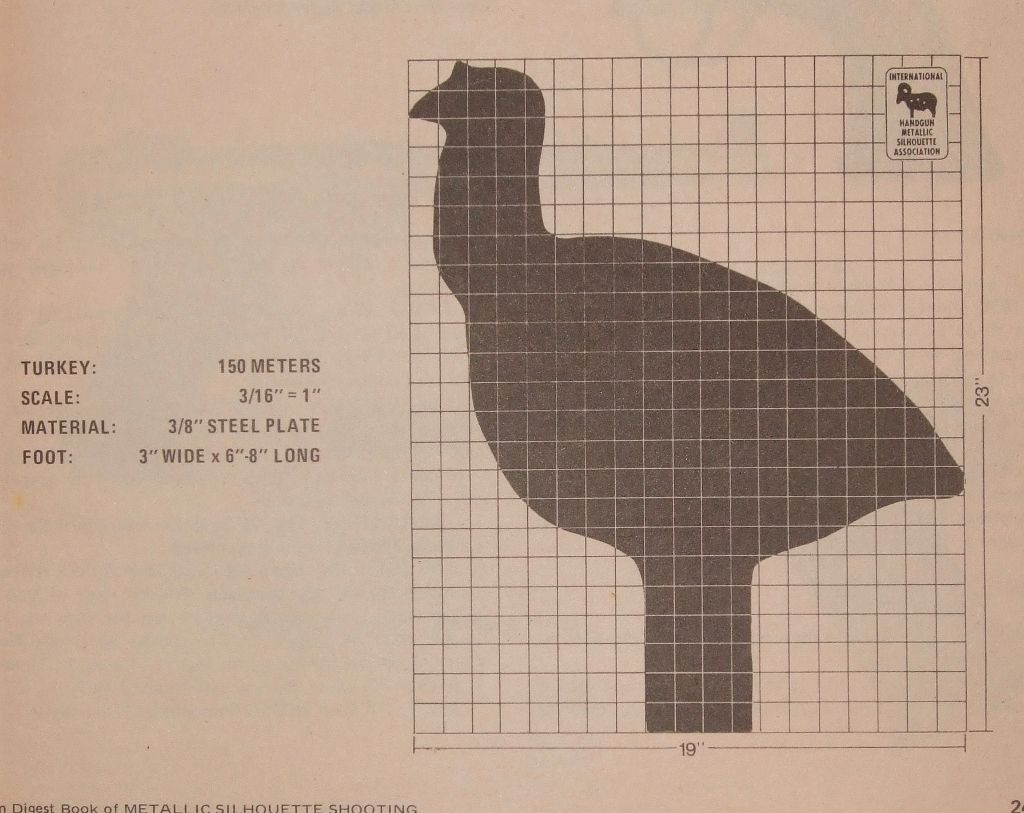
The ram is the most satisfying of silhouettes to watch fall. Weighs more than its iron relatives, falls more slowly, and projects a certain majesty. The body is easy to measure your sights by: back-to-belly measures 12-inches; shoulder-to-butt encloses 24-inches. An 1/8-inch front blade nearly covers the 2-foot width. As with the other targets, a 6 o’clock hold that touches meat yields best target visibility. A 6 o’clock hold——just touch meat----works for all the steel family
A revolver capable of 6-inch groups @ 200 meters allows just 3” above and blow the group to keep bullets on target. Thus, when we speak of SILHOUETTE ACCURACY, we have a specific performance in mind
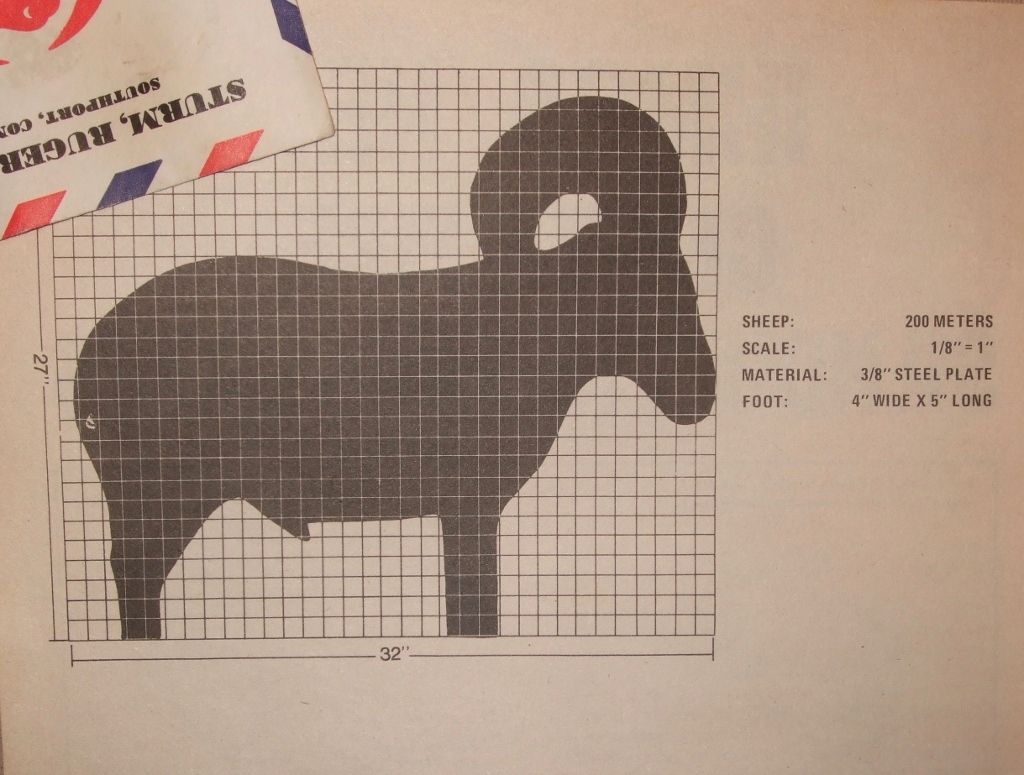
-Lee
www.singleactions.com
"Chasing perfection five shots at a time"
T/C dominated Production with its Contender, priced for the blue collar dollar. Single shot pistols chambering rifle-esque cartridges and featuring fast lock times made life rough for the revolver. Calls for a separate Revolver category fell on deaf ears. Revolver shooters fought back the only place where prestige cannot be bought----on the firing line. Among revolver shooters, top guns included Colt Python (no other Colt), S&W M-27, and the Dan Wesson Arms M-15. Choice among .41 Mags, the M-57 with 8-3/8” barrel. Selection of .44 mags seesawed between S&W M-29 and the Ruger Super Blackhawk.
David with two hard shooting .44’s. Photo taken by Elgin Gates in Arizona.

Competitors shoot XP-100 .221 Fireball in Production, Creedmoor position (foreground). The little crater-maker .221, a shortened .222 Remington, was guaranteed to ring targets. Nevertheless, the pistols enjoyed cult status in some areas. Rocks & Dynamite loads featuring the Speer 70 grain .224 semi-spitzes brazed a few bolt faces, proving the incredible strength of the Remington action. Laser beam trajectory obviated need to adjust abomination of a rear sight.

Remington XP-100 .221 Fireball single shot pistol shares solid bottom receiver of 40-X target rifle, rigid in the extreme. Dupont Zytel Buck Rogers stock allow pistol to make 4 lbs limit for Production guns

Competitor awaits ”FIRE” command at Jackson Center, Pennsylvania, close to the Ohio border. Jackson Center sported a group of alchemists dedicated to inflicting maximum target damage with Remington’s little screamer. Gentleman offered David a Mauser Model 3000 in 7mm Rem Mag, a fine copy of the SAKO: $250 or $275——with Leopold 2x7x! Alas, such money was needed for silhouette.

The sidewinder enjoyed among freestyle positions a modest following. Requires a wrestler's neck to hold up your head through an 80 round match, such as this championship. Neck strain of course leads to eye strain, neither of which afflicted this shooter

Original XP-100 as chambered in a shortened .222 Remington, dubbed “Fireball,” a fitting appellation for the small bore cannon. A bolt action of extreme strength, and the basis of most custom Unlimited pistols

This pockmarked chicken obviously was cut from 1/2” mild steel. The .221 Fireball, and any warm 7mm or .30 craters mild plate as well. As will an especially fast .44 Magnum loaded with Rocks & Dynamite, or likewise stoked .357 Maximum. Over time most mild targets were replaced with T-1. When a target breaks, or feet fall off, a tough electrode such as 7018 works much better than milder series rod

Pennsylvania sharpshooter Bechtel (blond) jawbones with Region One Director Ron Ricci. Bechtel, believes present writer, shot the first 40x40 east of the Mississippi. During this tournament the Calcutta Auction came down to Bechtel and Bradshaw.

David puts his new Unlimited pistol to work at a Ron Ricci’s match, Camp Curtis Guild, Massachusetts. The XP was built by Nevada maestro Skip Talbot, who shot the 40x40 and 60x60 records. Douglas air-gauge 1:9, 7mm/308x1-3/4”. Thumbhole stock by Western Gunstock’s George Petersen. Blade front sight .075”; Micro rear, narrow notch. Talbot 1-lb. rework of Remington center-grip trigger. Glad bedded, secured by forward action screw only. Talbot copied his own gun for David.

Nephew and spotter Jeff Kolok looks on as the shooter checks each silhouette for Point of Impact. This must be done as target setters lift silhouettes back on the stands——before painting bullet splashes. One perfect score had been fired east of the Mississippi, and few in the country

Ron Ricci congratulates shooter on the first 40x40 in New England


Scaled template of chicken shows a shootable rectangle in the body 5” high x 6” wide——but such an optimistic zone invites a miss. An 1/8-inch (.125”) front sight covers about 6” at 50 yards meters, depending on eye relief. The closer to your eye the front sight, the more target it covers. Creedmoor position offers the longest eye relief, and the blade covers less target.
Prone imposes the shortest eye relief of any position, and the front blade covers more target. Focus mind on the target. Focus eye or eyes on front sight. The rear sight may look a bit fuzzy----not as fuzzy as the target

The pig is proportionately the largest silhouette. And, arguably, the most symmetrical——since it is closer and therefore easier to see than the ram. The pig is the roadmap for tuning your sights, and the roadmap on which to begin doping wind——especially shooting the revolver; 100 meters is distance enough to bend a revolver bullet.
The chicken is too close and falls so fast it is difficult to spot. And the chicken is too close to dope wind. A good place to hold on the pig is just over the front leg

The asymmetric turkey presents the most difficult silhouette to fix your sights on. It stands 150 meters (165 yards) from your muzzle——one and two third football fields. An 8-inch square just about fits in the body, but the shooter must hold tighter than that. An eighth-inch front sight covers most of the body.

The ram is the most satisfying of silhouettes to watch fall. Weighs more than its iron relatives, falls more slowly, and projects a certain majesty. The body is easy to measure your sights by: back-to-belly measures 12-inches; shoulder-to-butt encloses 24-inches. An 1/8-inch front blade nearly covers the 2-foot width. As with the other targets, a 6 o’clock hold that touches meat yields best target visibility. A 6 o’clock hold——just touch meat----works for all the steel family
A revolver capable of 6-inch groups @ 200 meters allows just 3” above and blow the group to keep bullets on target. Thus, when we speak of SILHOUETTE ACCURACY, we have a specific performance in mind

-Lee
www.singleactions.com
"Chasing perfection five shots at a time"



